“In most good stories it is the character’s personality that creates the action of the story.” Flannery O’Connor
A problem most of us face, perhaps more often than we let on, is how to get an idea for the next story. How to get started? We know that once we get started it will be okay. We’ll find our way, but it may seem that we’ll never come up with an idea in the first place.
For years I’ve travelled Minnesota teaching reading and writing skills in schools as a residency artist. I do this by teaching kids to write stories. It is a great gig if you can get it. The challenge is that you usually only have four one-hour (sometimes less than one hour) sessions to lead the classes through the creation of a good first draft. The problem of how to get an idea and get started is built into the program.
This problem forced me to come up with a way to get everybody in the room well-started on the very first day. It also taught me one way to overcome the Oh-God-I’m-Stuck-for-an-Idea problem.
Naturally, the developmental stage of each grade level had to be taken into account, but I came up with an idea that, with tweaking, works beautifully for students from 5th grade up through adulthood. We’ll leave how I get the younger kids going out of this for now. Oh, and, by the way, I’ve used this exercise for my own stories from time to time. A couple of the stories I’ve used it for won national awards. One of them, “Babuji,” is posted on this newsletter.
The exercise is based on a simple enough idea: Stories grow out of the lives of characters. So, to get started, every student creates an original, never-before-seen-in-the-known-universe character. Working with kids, it’s a herding cats magic trick of class discipline and motivation. You do it, though, by asking yourself questions (and making up your own answers) about your character. The questions you ask are meant to imagine this fictional character’s life because (mantra) stories grow out of the lives of characters. The questions have to do with where the character lives and with whom, who the character is socially, professionally, the character’s personality, perhaps history, fears, ambitions, etc. In short, make up questions getting at whatever you want to ask about the character’s life.
Once you have imagined this life, it’s time to discover in that life a challenge—or, as I put it for kids, a problem, big or small, growing out of, being suggested by, somehow connected to what you have written down about your character. This initiating conflict is the engine of the story. Having named that conflict, you need to imagine a specific place (bedroom, grocery store, airport boarding gate, lawyer’s office) where your character is going to be at the very beginning of the story already experiencing the problem or just about to be introduced to it. Okay. Who else is there and what’s a single word that would describe how your character feels? These are the basic ingredients of an opening scene: a character facing an issue, a place and set of actors enacting a scene.
Write that scene. Know how your character feels, but don’t use the word (or synonym) that telegraphs that feeling. Let your reader infer it from the drama of dialogue and action. Once you’ve done this, be surprised and delighted by what pops out of your imagination and onto the page as you follow dramatic structure to the end of your rough draft. After that, as you revise and revise and revise, allow the characters to tell you what they are going to do and argue with you when you try to impose your ego on them.
I’ve done this exercise with thousands of people, adults and children alike. Follow these simple steps: (1) Create a character (that is, imagine a character’s life), (2) Give that character an issue to deal with, (3) Plunk the character down in a scene where the issue comes up and has to be dealt with. This will work at getting you started on a rough draft.
Understand as you do this that you will also do multiple revisions to finish the story, and that you may very well end up revising out the scene you started with. Indeed, everything may change. Getting a rough draft is messy, like a potter throwing mud on the wheel, then spinning spinning spinning to shape that mess into a piece of art ready for the final stage in the kiln. The rough draft is the crudely shaped mud. You are the artist who refines it.



